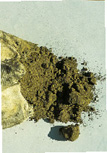

I purchased this henna powder in a shop in Ramallah.
HENNA EXTRACTS ARE NOW COMmon in various cosmetics, particularly shampoos, continuing a traditional use for centuries.
Henna is a many-branched shrub that grows to a height of about 3 meters (12 feet). Leaves are small and elliptic. The individual flowers, borne in the spring, are small but produced in large masses and are very fragrant. The dried flowers retain the heavy scent. Today henna is often grown as an ornamental.
The henna plant, Lawsonia inermis, is probably native to North Africa but may have been grown in hot oases such as Ein Gedi. This beautiful oasis sits between the Dead Sea and the precipitous cliffs of the Judean Desert and is a place where many medicinal and cosmetic plants were grown in ancient times. The climate is tropical and there is an abundant supply of water. The Bible offers a sensuous allusion to henna and the oasis: “My beloved is unto me a cluster of henna flowers in the vineyards of Ein Gedi” (Song of Solomon 1:14, NIV). The intense fragrance of the henna is also suggested in Songs of Songs 4:13, where it is mentioned with spikenard, probably Nardostachys jatamansi.
The main use of henna is as a cosmetic. Today the highest quality henna in the Middle East is imported from Iran. The leaves are dried and crushed into a fine powder. This powder is mixed with water and allowed to sit for two days to make a paste that forms a reddish dye, which is then painted on the fingernails, hands, and feet as ornamentation, often with intricate designs. Henna is also used to dye the hair. While it is used in several countries, I have seen henna most widely applied in Sudan, especially to adorn the bride at a wedding.

Flowers on an ornamental henna plant in a Jericho garden.

A bride adorned with henna designs performing the traditional “pigeon dance” at a Sudanese wedding. In Sudan and some other countries, the extent of henna application on wedding guests is in proportion to relationship with the bride or groom. A sister may have one arm or both arms adorned. As a guest but not a family member, I was invited to have my thumb stained. Photo by Libby Musselman.
In Bible days, cosmetic use of henna may have been even more widespread. There is a reference in Deuteronomy 21:12, which may allude to the need for the colored hair and nails to grow out. While henna was certainly used in ancient times as a cosmetic, the only reference to it in the scriptures relates to the plant’s fragrant flowers.